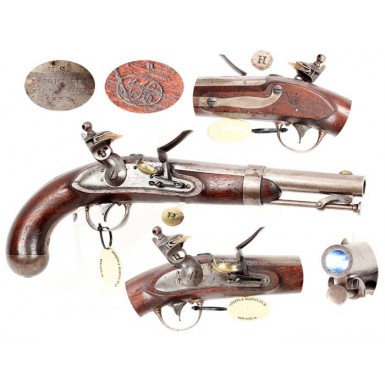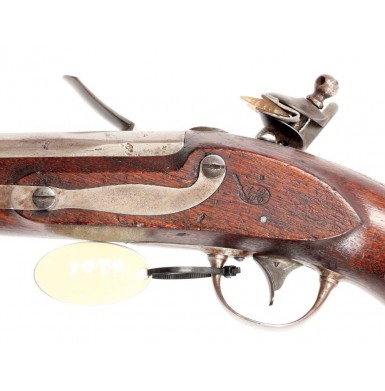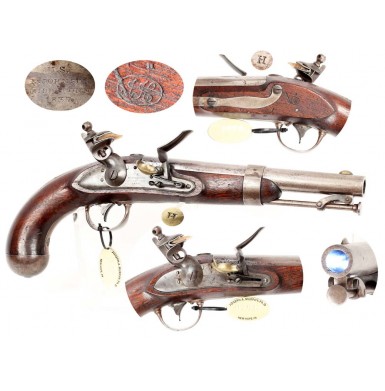The US M-1836 Pistol was a unique handgun in the history of US martial arms. It was the last of the single-shot martial flintlock pistols to be authorized and contracted for by the US government, and it was the first contract small arm to be designed by the contractor, and not based upon a US armory produced sample firearm. A total of 41,000 of the pistols were contracted for between 1836 and 1844. Robert Johnson of Middleton, CT designed the pistol and produced a total of 18,000 of the gun. Asa Waters of Millbury, MA produced the balance of 23,000 of the pistols. The contract was entered into at a very tumultuous time in US military history. The Second Seminole War had erupted in December of 1835 and both the newly authorized 2nd US Dragoons and the many mounted state militia troops that were sent to swamps of Florida to deal with the situation were in need of pistols. The stores of pistols in US arsenals were rather small at this point of time. Most of the pistols in storage were the obsolete and rather bulky US M-1816 pattern, which was not considered to up to the current standards for military use. The lack of pistols was further exacerbated by the very limited production of contract handguns over the previous decade. As a result of the need to arm the US Dragoons, state militia troops being called up for the war and to catch up on backordered requisitions for arms from the states under the Militia Act of 1808, extreme pressure was applied to both the contractors to deliver the guns and the US ordnance inspectors to approve them for service. This created a pressure point in the facilities of the contractors where assembled pistols sometimes languished while waiting for an Ordnance Department inspector and accepting officer to view the pistols. New standards for small arms inspection had been published in the Ordnance Regulations of 1834 and specified that two inspectors would view the contract ordnance. The Armory sub-inspector (a civilian employee of one of the US arsenals; normally Springfield) would inspect each part in detail, stamping his initials on proved barrels prior to their assembly into complete arms, and inspecting the various parts of the arms both large and small. The sub-inspector would also inspect the finished product, disassembling the arms as necessary and affixing his initial to the major components of the gun; the old saying “lock, stock & barrel” originates here. The inspector would mark all of the completed arms on the underside of the flash pan, the stock flat opposite the lock, and the left breech flat with his initial. He would further mark the stock with his cartouche, verifying that the gun had been completely inspected. The Ordnance Department accepting officer would then double check the inspection, although not in such detail, and would stamp his acceptance cartouche on the stock flat, indicating the gun had been accepted for US service and verifying that it could be paid for. The Ordnance Officer who was appointed as the “Superintendent of Inspection” was expected to personally view (at least casually) and mark all contact small arms and accouterments being delivered to the US government. This was a massive undertaking for any one person, who had to preform the inspections at the contractor’s manufactory, and not at a central depot. The difficulties in making the necessary personal inspection of contract arms during this period have lead collectors to note a number of variant US M-1836 pistols that have only a single inspection cartouche; that of the arsenal sub-inspector, but without the cartouche of the Ordnance Department accepting officer. The diligent research of American Society of Arms Collector member Lewis F. Southard has allowed collectors to identify the likely disposition of certain examples of Johnson contract US M-1836 pistols that bear only a single cartouche. By delving into both Johnson factory records and the US Ordnance Department records and correspondence, he has established 3 occasions where Johnson delivered US M-1836 pistols without an accepting officer’s cartouche. During this time, Major Henry Knox Craig of Watertown Arsenal was also the “Superintendent For Inspection” of contact arms and accouterments. Craig was simply swamped by this duty and much of the correspondence unearthed by Southard relates to his requests for help from the head of the US Ordnance Department, Colonel George Bomford. The first two occasions when Craig could not be present to inspect Johnson’s pistols were in 1837. The first was a March 11, 1837 inspection, when sub-inspector Thomas Warner inspected M-1836 pistols at Johnson’s facility without Craig there to accept the pistols. The guns are marked with Warner’s script TW cartouche, but do not carry Craig’s HKC mark. Craig was simply spread too thin on contract inspections to be there. The March 11 inspection was for 500 pistols that were subsequently sent to the New York Depot for issue to the 2nd US Dragoons for Seminole War service. These pistols are identifiable by locks dated 1836 or 1837, inspection marks applied by Thomas Warner, and no “HKC” cartouche. The next group of Johnson contract “single cartouche” pistols were inspected by armory sub-inspector Joseph Hannis on October 5, 1837. This group of 500 guns included some with Thomas Warner inspected barrels, left over from an August 1837 inspection of parts by Warner. The balance of the gun is inspected by Hannis, with his small H on the major components and his script JH cartouche on the stock flat. Craig could not be present at the October 5 inspection, as he was inspecting powder flasks at the Ames facility in Cabbotsville, MA on that date. These pistols are all 1837 dated, are fully inspected by Hannis and again bear no “HKC” cartouche. It seems likely that most of the 500 pistols from the October 5 inspection were delivered for use by the Tennessee militia, which had been called out for service in Florida. Southard quotes a September 15, 1837 letter to Ordnance Inspector Craig form Colonel Bomford of the Ordnance Department stressing the need to deliver 600 pistol to the Tennessee volunteers that were being sent to Florida to fight the Seminoles. The final group of “single cartouche” pistols was inspected by armory sub-inspector Lewis Foster on August 18, 1838. These 600 guns were delivered to the state of Georgia for Seminole War service as well. They are identifiable by their 1838 lock dates, Foster’s inspection marks throughout, and again the lack of Craig’s inspection mark. Due to the wonderful research conducted by Mr. Southard, we can with some degree of accuracy attribute the destination of these single cartouche US M-1836 pistols by Johnson, and we know that they were all bound for Seminole War service. A copy of Mr. Southard’s detailed article accompanies this pistol.
This is a very attractive US M-1836 pistol (Flayderman 6A-034) that is in VERY FINE overall condition. The gun is an 1837 dated example by Johnson that bears a single JH inspection cartouche and does not bear a Henry Knox Craig acceptance cartouche. Due to the research by Mr. Southard, we can be relatively certain that this gun was inspected on October 7, 1837 and was almost certainly delivered for use by the Tennessee volunteer militia that served during the Second Seminole War. The pistol is extremely crisp and remains in its original flintlock configuration. This is quite uncommon with these pistols as the majority of these guns ended up being altered to percussion between the mid-1850s and the beginning of the Civil War. This US M-1836 Johnson contract pistol is clearly marked on the lock in four lines forward of the hammer: U.S. / R. JOHNSON / MIDDN CONN / 1837. The breech is clearly marked in three lines: U.S. / TW / P. The TW is the mark of armory sub-inspector Thomas Warner, and is probably a barrel left over from his inspection of barrels in August of 1836. The stock flat opposite the lock a single crisp and fully legible script JH cartouche. This is the mark of Armory Sub Inspector Joseph Hannis. Hannis’ tiny block letter H mark is also present on the bottom of the brass flash pan, on the left breech flat of the barrel, and on the stock flat, above the inspection cartouche. The pistol is in VERY FINE condition overall, with very nice metal that is quite smooth throughout with only minor peppering and pinpricking present, mostly around breech & flash pan area, and the muzzle area of the barrel. The metal appears to have been very lightly cleaned at some point in the past, and is toning down very nicely. The gun has a medium pewter patina with a thin brown patina forming over the iron barrel and furniture. There are also some lightly scattered areas of age staining and oxidized discoloration on the metal of the pistol. The lock retains about 30% of its original color case hardened finish, with attractive bluish-purple mottling most visible on the lower portion of the plate between the hammer and the flash pan. The lock is mechanically excellent and functions crisply and correctly on all positions. The frizzen remains nice and tight, working as it should, with only some minor surface wear on the face. The brass pan shows good age and shows some light verdigris near the touchhole, and old powder residue and stains in the bottom of the pan. The bottom of the pan shows the correct sub-inspector mark H. The interior of the lock is completely untouched and unmolested, showing the perfect and precise fit of an original flintlock battery. The touchhole is well centered both vertically and horizontally in the pan. The touchhole shows some minor erosion, commensurate with the appearance of the metal on the barrel around the breech area. The iron furniture matches the barrel of the gun perfectly and is free of pitting, with only some very light scattered areas of light peppering, matching the barrel of the pistol perfectly. The .54 caliber smooth bore is in >FINE condition, showing only some minor discoloration, but remaining mostly bright with only some lightly scattered pitting along its length. The original swivel rammer is in place under the barrel and it functions perfectly. The some of the small metal parts show small sub-inspector marks, including a V on the top left side of the trigger and a small X on the left upper side of the top jaw. The original swivel ramrod is in place in the channel under the barrel and operates smoothly and correctly. The stock is in VERY FINE to NEAR EXCELLENT condition, and it is solid and complete with no breaks or repairs. The stock is very crisp and sharp throughout, without any indications of any sanding or even serious cleaning. The grain remains open and attractive, and the edges are razor sharp along the stock flat. There is a tiny surface grain crack present at the tail of the lock mortise, but that is the only stock issue of any significance or worth mentioning specifically. The stock does show some minor handling marks, with the expected dings, bumps and rubs, as would be expected from a military pistol that is over 175 years old. The stock shows no significant wear and absolutely no abuse, and has an extremely pleasing look to it overall.
All in all this is a really attractive and very crisp example of the last official US Martial Single Shot Flintlock pistol. The gun is in wonderful original flint condition, which is rare for any late model marital flintlock weapon. These pistols were the standard issue handguns during the Second Seminole War and the Mexican War, and nearly all of the surviving pistols saw additional Civil War service of some sort. This one is particularly interesting in that it is quite certain that it saw at least some limited Seminole War service, almost certainly in the pommel holster of a Tennessee volunteer militia man. The gun has wonderful provenance, having been a part of Dr. Joseph Murphy’s collection (New Hope, PA). Dr. Murphy’s collection of US martial flintlock pistols was one of the best in the world, both in quality and rarity, and Dr. Murphy’s collection tag remains attached to the triggerguard. If you have been wanting to add a really high condition flintlock pistol to your US martial handgun collection, it would be hard to beat this one for overall crisp condition, completeness, history and provenance.
. SOLD







